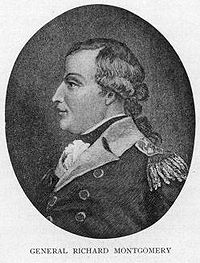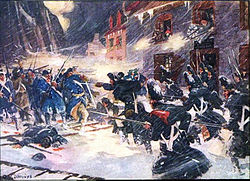American Revolution/The Invasion of Canada
The Plan[edit | edit source]
As the conflict around Boston was in a stalemate, American Continental Congress sought a way to seize the initiative elsewhere. Congress had previously invited French-Canadians to join the American Revolution as the fourteenth colony, but this was rejected. Therefore, a plan was devised to drive the British Empire from the primarily francophone colony of Quebec. Two expeditions were undertaken.

Congress authorized General Philip Schuyler, commander of the Northern Department, to mount an invasion to drive British forces from Canada. He sent General Richard Montgomery north with an invasion force. General George Washington, who had recently been appointed General and Commander-In-Chief, also sent Benedict Arnold towards Quebec City with a supporting force.
Mongomery's Expedition[edit | edit source]
Philip Schuyler was to have led the invasion. On September 12, 1775, he led an expeditionary force to Fort St. John (Saint-Jean-sur-Richelieu), where he addressed the populace with a proclamation promising the respect of "their persons, property, religion, and liberties." But Schuyler fell ill and was replaced by Brigadier General Richard Montgomery. On September 16, 1775, Montgomery marched north from Fort Ticonderoga with about 1,700 militiamen.
They arrived on September 19 and, after a forty-five day siege, they defeated the British at the Battle of Fort St. Jean on November 3. Montgomery's troops continued north and occupied Saint Paul's Island on November 11, crossing to Pointe-Saint-Charles on the following day.
Montreal fell without any fighting on November 13, as Major-General Guy Carleton, the governor of Quebec, had escaped to Québec City with his troops.
Montgomery then moved towards Quebec City with the bulk of his troops on November 28, leaving Montreal under the command of General David Wooster. The historic Château Ramezay served as Continental Army HQ in Montreal.
Arnold's Expedition[edit | edit source]
Preperations[edit | edit source]
The second expedition was led by Benedict Arnold. In 1775, the Continental Congress generally adopted Arnold's plan for the invasion of Canada, but Arnold was not included in the command structure for the effort. Thus rebuffed, Arnold returned to Cambridge, Massachusetts, and approached George Washington with the idea of a supporting eastern invasion force aimed at Quebec City. Because there had been little direct action at Boston after the Battle of Bunker Hill in June, many units were bored with garrison life and eager for action. Washington agreed with Arnold's proposal. He appointed Arnold a colonel, and together they visited each line unit to ask for volunteers.
Arnold eventually selected a force of 750 men. Washington added Daniel Morgan's company and some other riflemen. The frontiersmen, from the Virginia and Pennsylvania wilderness, were better suited to wilderness combat than to a siege.

The Expedition[edit | edit source]
The plan called for the men to cover the 180 miles (290 km) from the Kennebec River to Quebec in 20 days. They expected to find relatively light defenses since British Commander Carleton would be busy handling Schuyler's forces at Montreal. Arnold sent ahead to Fort Western (in the Province of Maine) to have supplies and bateaux readied for his force. The expedition moved by sea and spent five days at Fort Western organizing supplies and preparing the boats.
The men expected to go up the Kennebec River and then descend the Chaudière River to Quebec. After staying for three days at Colburn's Shipyard in Gardinerston, where Reuben Colburn built the bateaux at Washington's request in just 15 days, they set out from Fort Western on September 25. Their troubles began almost immediately.
The bateaux were built from green, split pine planks because of a lack of dried lumber at that time of year and were basically flat bottom rafts that could not be rowed but had to be poled against the stream. Colburn traveled with the army, repairing the bateaux as they went, but in hauling them upstream and lowering them down the Chaudiere, many supplies and some men were lost. Rain and violent storms ruined more. Lieutenant Colonel Roger Enos turned back with his division, taking 300 men and some of the supplies with him.
The maps the expedition had started with were faulty, since the British frequently allowed publication of incorrect maps to deceive future enemies. The journey turned out to be 350 miles (560 km), not 180. After the expedition ran out of supplies, the men began to eat anything, including their dogs, their shoes, cartridge boxes, leather, moss, and tree bark. On November 6, the expedition reached the south shore of the St. Lawrence River; Arnold had 600 of his original 1,100 men.
However, Arnold thought they could still take the city. The defenders were only about 100 British regulars under Lieutenant Colonel Allen Maclean, supported by several hundred poorly organized local militia. If the Americans could scatter the militia with accurate fire, they could overwhelm the outnumbered regulars. When they finally reached the Plains of Abraham on November 14, Arnold sent a negotiator with a white flag to demand their surrender, but to no avail. The Americans, with no cannons, faced a fortified city. When the frigate Lizard moved into the river to cut off their rear, they were forced to withdraw to Pointe aux Trembles.
Finally, on December 2, Montgomery came down river from Montreal with 300 troops and bringing captured British supplies and winter clothing. The two forces united, and plans were made for an attack on the city.
The Battle of Quebec[edit | edit source]
The attack began at 4:00 a.m. on December 31, 1775, with Montgomery launching signal rockets. The British were prepared for the Continental assault, as deserters from the Continental Army were straggling into Quebec.

The two brigades were supposed to meet at the tip of the St. Lawrence river and move into the walled city itself. However, the fortifications proved to be too strong to be taken by force. Montgomery's brigade advanced along the river coastline under the Cape Diamond Bastion, where they came to a blockhouse barricade at Près-de-Ville manned by about 30 French-speaking militia. Montgomery advanced his brigade towards it at a walk, and the militia responded with a volley that cut down Montgomery and the brigade's two other highest ranking officers. The next highest ranking officer ordered a retreat, while the militia continued to snipe at them.
Benedict Arnold was unaware of Montgomery's death and his attack's failure, and he advanced with his main body towards the northern barricades. They were fired upon by British and local militia manning the wall of the city. Upon reaching a street barricade at a street called Sault au Matelot, Arnold was wounded in the left ankle by a musket ball and was taken to the rear. With Arnold out of action, his second-in-command, Daniel Morgan, took command and captured the first street barricade. But while awaiting further orders, the colonists were attacked from the street and surrounding row houses by hundreds of militia. A British counterattack reoccupied the first barricade, trapping Morgan and his men within the narrow streets of the city. With no way of retreat and under heavy fire, all of Morgan's men surrendered. By 10:00, the battle was over, with Morgan surrendering himself and the last pocket of Continental resistance in the city.

Arnold refused to give up and—despite being outnumbered three to one, the sub-freezing temperature of the winter and the mass desertions of his men after their enlistments expired on December 31, 1775—laid siege to Quebec. This siege had little effect on the city.
Arnold (now a Brigadier General) was reinforced with Wooster's brigade in March 1776, bringing their strength to 2,000 men.
The British Counter-Attack[edit | edit source]
On May 6, 1776, a small squadron of British ships under Captain Charles Douglas arrived to relieve Quebec with supplies and troops, forcing the Americans to immediately retreat. A few weeks later, British forces in Quebec were strengthened by even more troops under General John Burgoyne and Hessian mercenaries. Another attempt was made by the Revolutionaries to push back towards Quebec, but it failed at Trois-Rivières on June 8, 1776. The new American commander, General Thomas, died of smallpox.
Carleton then launched his own invasion and defeated Arnold in the Battle of Valcour Island in October. Arnold fell back to Fort Ticonderoga, where the invasion of Canada had begun. The invasion of Canada ended as a disaster for the Americans, but Arnold's improvised navy on Lake Champlain had the effect of delaying a full-scale British counter thrust until the Saratoga campaign of 1777. Carleton was heavily criticized in London for not pursuing the American retreat from Quebec more aggressively, and so command of the 1777 offensive was given to General Burgoyne instead.